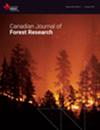生物量收获和除草剂施用对杰克松为主森林中枯枝落叶节肢动物群落的累积影响:收获后第7年评估。
IF 1.5
3区 农林科学
Q2 FORESTRY
引用次数: 1
摘要
森林生物质收获有可能为能源生产提供原料,以抵消化石燃料的消耗。然而,人们对从森林中清除额外生物量的生态可持续性,特别是对生物多样性的影响表示关切。在这篇论文中,我们使用了一套地面节肢动物分类群(地甲虫、蜘蛛和漫游甲虫)来测量收获后7年生物量去除处理梯度的群落组成变化,并与参考进行比较。基于多元回归树,物种组成的变化反映了生物量去除处理的强度梯度或与所有节肢动物群的森林地面干扰水平相关的林分属性。对于每个节肢动物群,组成的变化主要是由丰富的森林相关物种的减少或损失,以及与更多干旱条件和干扰强度增加相关的物种数量和丰度的增加来定义的。全树处理和树长处理之间没有差异。总体而言,研究结果表明,节肢动物对主要由草甘膦施用引起的林下覆盖物的清除、森林地面干扰和减少有强烈的反应。节肢动物的恢复将受益于过度储存、减少对森林地面的干扰和草甘膦的司法使用。本文章由计算机程序翻译,如有差异,请以英文原文为准。
Cumulative effects of biomass harvesting and herbicide application on litter-dwelling arthropod communities in jack pine-dominated forests: 7th year post-harvest assessment.
Forest biomass harvest has the potential to provide feedstocks for energy production to offset fossil fuel consumption. However, concerns have been raised regarding the ecological sustainability of removing additional biomass from forests, in particular the impacts on biodiversity. In this paper we used a suite of ground-dwelling arthropod taxa (ground beetles, spiders, and rove beetles) to measure community compositional changes along a gradient of biomass removal treatments 7 years post-harvest, and compared against reference. Based on multivariate regression trees, changes in species composition reflected the intensity gradient of the biomass removal treatments or stand attributes associated with the level of forest floor disturbance across all arthropod groups. For each arthropod group, changes in composition were defined primarily by reductions or loss of abundant forest associated species and increases in the number and abundance of species associated with more xeric conditions and increased disturbance intensity. There were no differences between full-tree and tree-length treatments. Overall, results indicated a strong arthropod response to the removal of overstory, forest floor disturbance and reductions in understory cover mostly resulting from the glyphosate applications. Arthropod recovery would benefit from overstory retention, reduction in forest floor disturbance and judicial use of glyphosate.
求助全文
通过发布文献求助,成功后即可免费获取论文全文。
去求助
来源期刊
CiteScore
4.20
自引率
9.10%
发文量
109
审稿时长
3 months
期刊介绍:
Published since 1971, the Canadian Journal of Forest Research is a monthly journal that features articles, reviews, notes and concept papers on a broad spectrum of forest sciences, including biometrics, conservation, disturbances, ecology, economics, entomology, genetics, hydrology, management, nutrient cycling, pathology, physiology, remote sensing, silviculture, social sciences, soils, stand dynamics, and wood science, all in relation to the understanding or management of ecosystem services. It also publishes special issues dedicated to a topic of current interest.

 求助内容:
求助内容: 应助结果提醒方式:
应助结果提醒方式:


